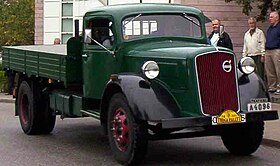
Volvo Aero was a Swedish aircraft, guided missiles and rocket engine manufacturer. It became GKN Aerospace Engine Systems following the company's acquisition by British engineering conglomerate GKN during 2012.

The Volvo PV800 Series was a taxicab manufactured by Volvo between 1938 and 1958. The Sow series dominated the Swedish taxicab market during the 1940s and 1950s.

The Volvo FL is Volvo's smallest truck and is suitable for local and regional distribution operations, refuse collection, construction truck or small format tractor. The Volvo FL has been built since the summer of 1985 in a variety of different models of different weight ratings. The latest model has been sold since 2013.

Sisu Auto is a truck manufacturer based in Raseborg, Finland. Its name comes from the Finnish word sisu meaning guts, grit and determination.

The Volvo FH is a heavy truck range manufactured by the Swedish company Volvo Trucks. It was originally introduced in late 1993 as the FH12 and FH16. FH stands for Forward control High entry, where numbers denominate engine capacity in litres. The FH range is one of the most successful truck series ever having sold more than 400,000 units worldwide.

The Volvo FM is a heavy truck range produced by the Swedish company Volvo Trucks. It was originally introduced as FM7, FM10 and FM12 in 1998. FM stands for Forward control Medium height cab, where the numbers denominate an engine capacity in litres. As of 2005 the engine size is no longer added to the model denomination. The FM range is a multipurpose truck range for distribution, construction and on highway/off highway transport duties. In 2013, Volvo Trucks announced an updated, Euro VI version of the Volvo FM.

The Volvo PV650 Series is an automobile manufactured by Volvo between 1929 and 1937. The model name stand for PersonVagn, 6 cylinders, 5 seats; the third digit indicates the version.

The Volvo LV4 was a light truck produced by Swedish automaker Volvo between 1928 and 1930. The designation LV4 stands for LastVagn (“truck”), 4 cylinders.

The Volvo LV60-series was a light truck produced by Swedish automaker Volvo between 1929 and 1932.

The Volvo LV76-79 was a light truck produced by Swedish automaker Volvo between 1934 and 1940.

The Volvo LV101-112, or the Sharpnose was a light truck produced by Swedish automaker Volvo between 1938 and 1950.
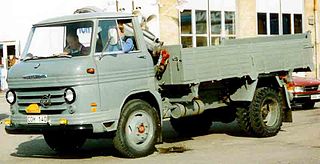
The Volvo Snabbe and Trygge was a series of light trucks produced by Swedish automaker Volvo between 1956 and 1975.

The Volvo LV71-series was a medium size truck produced by Swedish automaker Volvo between 1932 and 1935.
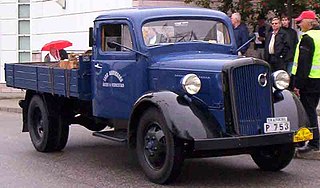
The Volvo LV80/90-series was a medium size truck produced by Swedish automaker Volvo between 1935 and 1940.
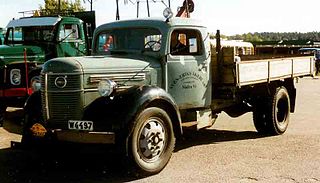
The Volvo LV120/130/140/150-series, or the Roundnose was a medium-size truck produced by Swedish automaker Volvo between 1939 and 1954.

The Volvo LV66-70 was a truck produced by Swedish automaker Volvo between 1931 and 1936.

The automotive industry in Sweden is mainly associated with passenger car manufacturers Volvo Cars and Saab Automobile but Sweden is also home of two of the largest truck manufacturers in the world: AB Volvo and Scania AB. The automotive industry is heavily dependent on export as some 85 percent of the passenger cars and 95 percent of the heavy vehicles are sold outside of Sweden. The automotive industry and its sub-contractors is a major part of Swedish industry. In 2011 around 110,000 people were employed and the export income of 150 billion SEK accounted for 12 per cent of Sweden's export income. During 2009 128,738 passenger cars and 27,698 heavy vehicles were built in Sweden. Koenigsegg is also a famous swedish company which makes some of the fastest cars in the world, but also some of the most expensive. They make cars like:Koenigsegg Jesko, Gemera, 1:One, Agera, Regera etc.

Volvo Trucks Corporation, stylized as VOLVO, is a global truck manufacturer based in Gothenburg, Sweden, owned by AB Volvo. In 2016, it was the world’s second largest manufacturer of heavy-duty trucks.
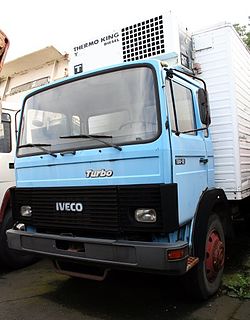
The Club of Four was an alliance of four European truck manufacturers: Saviem, Volvo, DAF, and Magirus-Deutz.
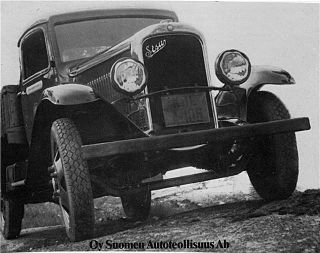
Sisu S-321, S-322 and S-323 is the first lorry and bus model series made by the Finnish heavy vehicle producer Suomen Autoteollisuus (SAT) in 1932–1934. Upgraded models S-341 and S-342 were produced in 1934. The vehicles were heavily based on Volvo components. The two-axle, 4×2-driven lorries were designated with 2 500 kg capacity and total weight of 4 800 kg.
